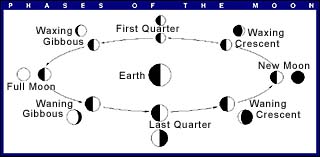| THE MOON SEEN FROM EARTH
At any one time, an observer can see only 50 percent of the moon�s entire surface. However, an additional 9 percent can be seen from time to time around the apparent edge because of the relative motion called libration. This is because of the slightly different angles of view from the earth, due to different relative positions of the moon along its inclined elliptical orbit.
The moon shows progressively different phases as it moves along its orbit around the earth. Half the moon is always in sunlight, just as half the earth has day while the other half has night. The phases of the moon depend on how much of the sunlit half can be seen at any one time. In the phase called the new moon, the face is completely in shadow. About a week later, the moon is in first quarter, resembling a luminous half-circle; another week later, the full moon shows its fully lighted surface; a week afterward, in its last quarter, the moon appears as a half-circle again. The entire cycle is repeated each lunar month. The moon is full when it is farther away from the sun than the earth; it is new when it is closer. When it is more than half-illuminated, it is said to be in gibbous phase. The moon is said to be waning when it progresses from full to new, and to be waxing as it proceeds again to full. Temperatures on its surface are extreme, ranging from a maximum of 127� C (261� F) at lunar noon to a minimum of -173� C (-279� F) just before lunar dawn.
|
